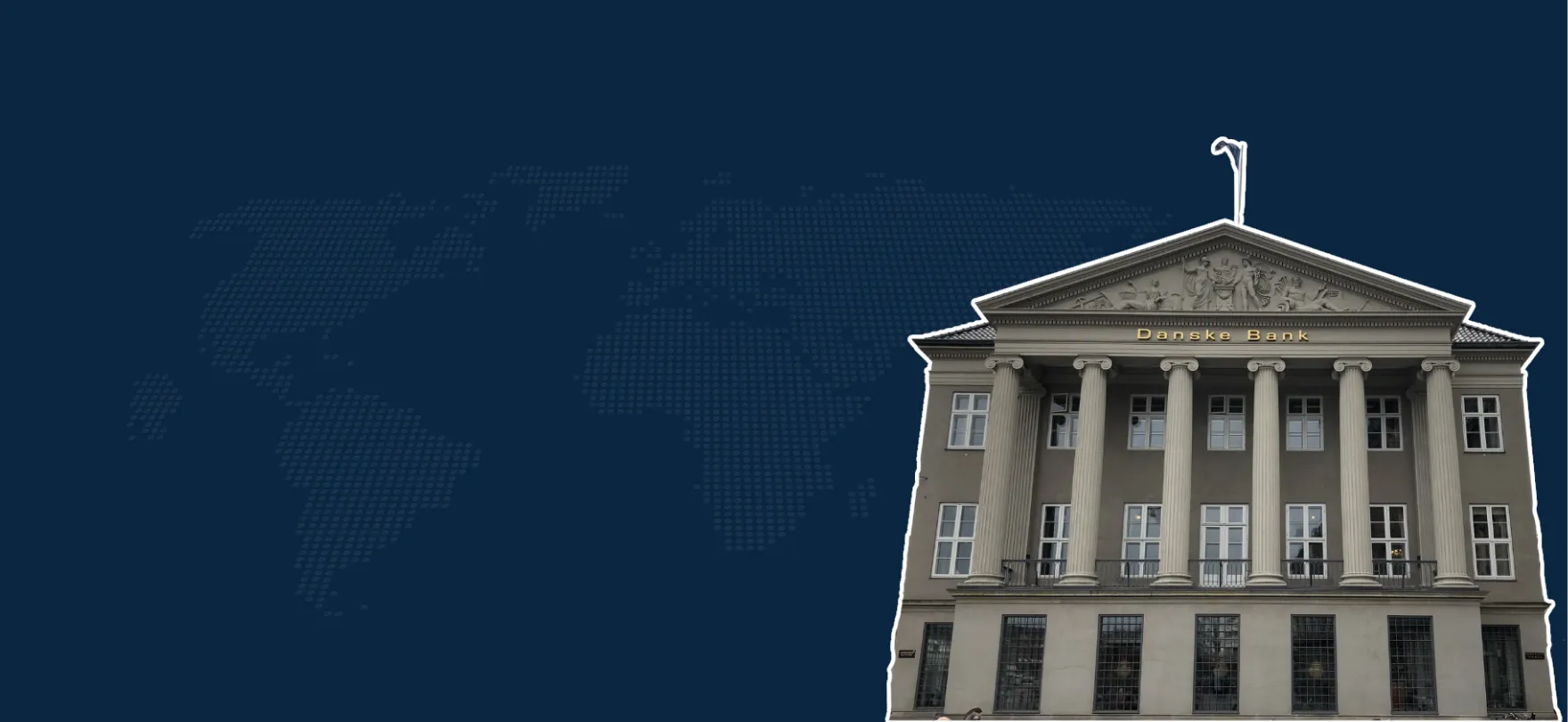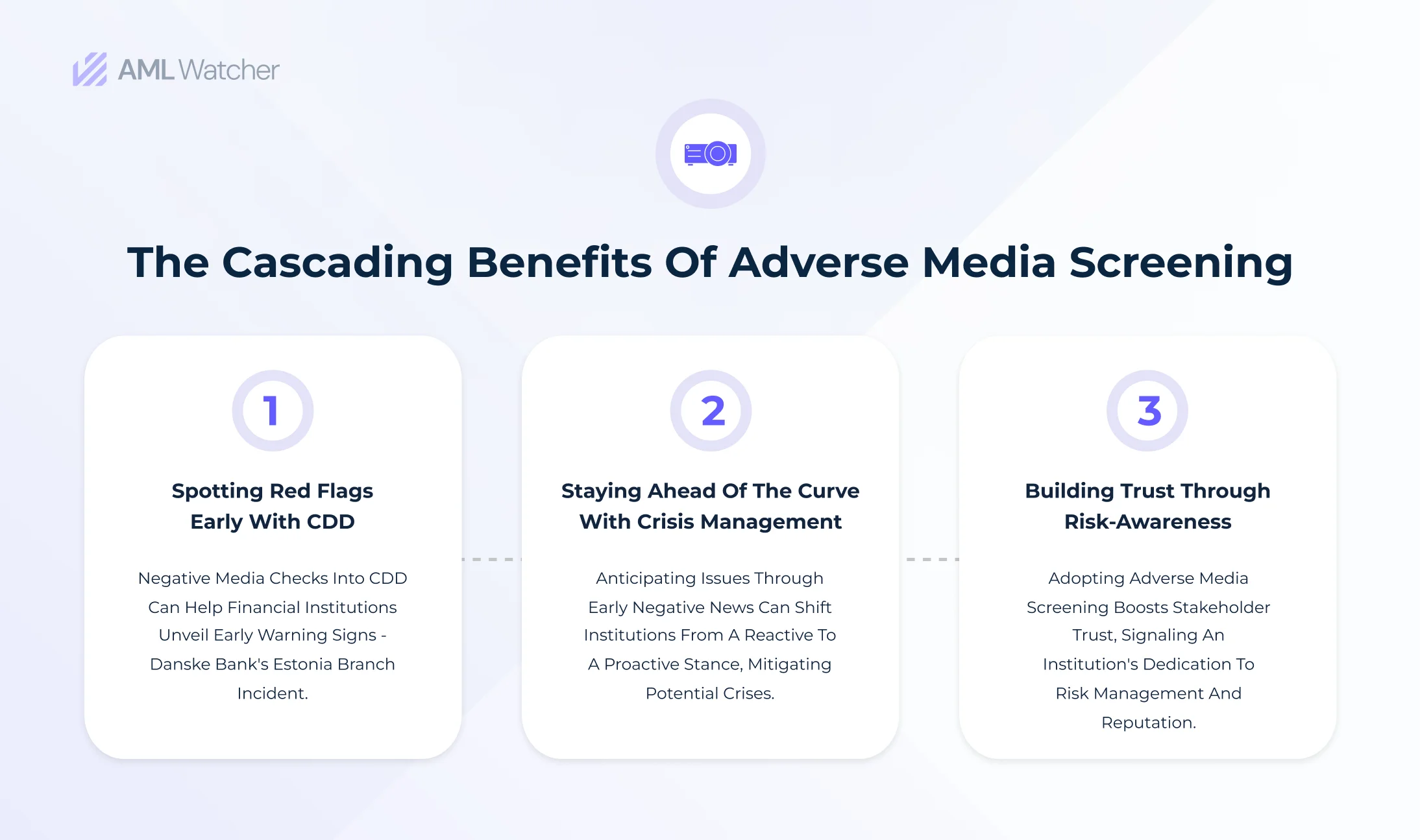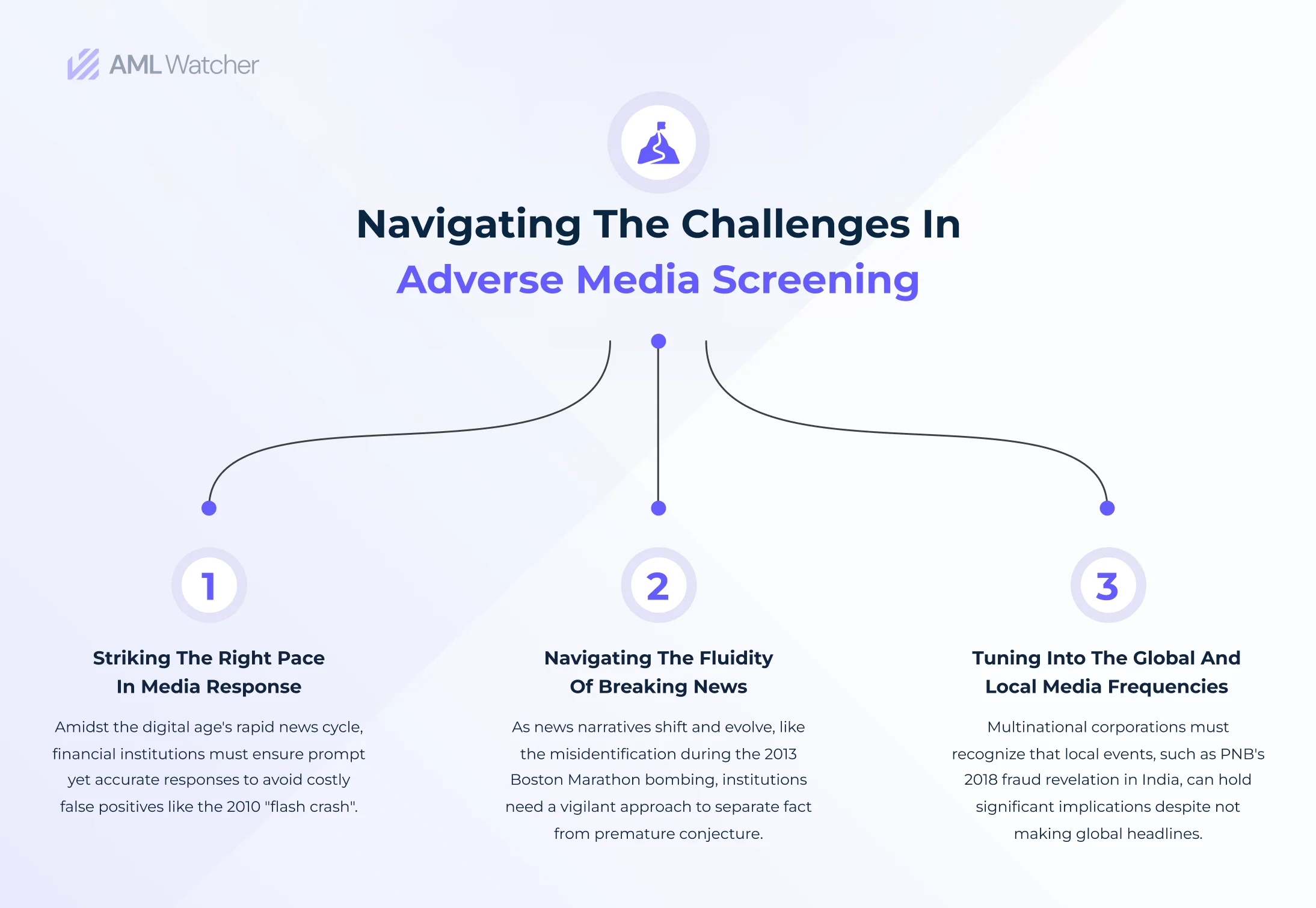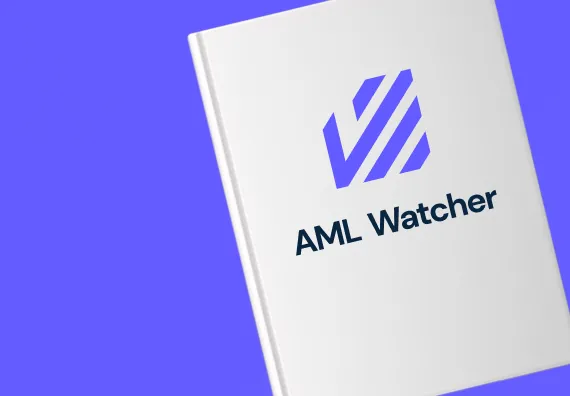
Why Should Financial Institutions Screen for Adverse Media? Navigating Risk in the Age of Information Overload
With over 5.3 billion internet users worldwide in 2023, information is shared throughout the huge networks of the internet at an astounding rate in this dynamic digital era. Every day, more than 500 million tweets are posted, over 4 petabytes of data are produced on Facebook, and every minute, 300 hours of video are uploaded to YouTube, demonstrating the unparalleled speed and boundless sharing of knowledge. But risks accompany this unparalleled reach. According to a study by the Oxford Internet Institute, coordinated disinformation efforts have been running in more than 70 nations, underscoring the worrisome dissemination of misleading information and dishonesty. Financial institutions are relying more on adverse media screening as a protective strategy in the midst of this unrest. It’s critical to identify possible hazards since money laundering and other worldwide financial crimes are thought to amount to 5% of the world’s GDP, or $800 billion to $3 trillion in a year, according to the United Nations Office on Drugs and Crime (UNODC). This painstaking procedure of negative media screening guarantees that organizations are shielded from unintentionally aiding these enormous amounts of illegal activity or partnering with malevolent entities.
Before studying about the risks which come with an information overload, it’s important to briefly understand what adverse media really is.
Understanding Adverse Media from the Beginning
Primarily known as “negative news”, adverse media is any information about people. Organizations, entities, and businesses that might pose a risk to the credibility and reputation of financial structure.
This type of media resource helps organizations make educated and informed decisions, preventing them from unintentionally supporting illegal activity.
Major Types of Adverse Media
Factual Adverse Media – as the name suggests is any unfavorable event or news which is supported by solid evidence and credible facts. Such news is not momentary rather it goes through several stages of verification to be labeled as credible. Proven records of court cases are the strongest source of this type of database. The US Department of Justice revealed that over 300 people had been found guilty of federal offenses, including $64 billion against penalties laid down by the U.S. Securities and Exchange Commission (SEC) in 2022 alone.
Speculative Adverse Media – as the name suggests is any unfavorable information based on random speculations, assertions, and accusations or suspicions. These media adversaries are usually based on ongoing investigations or rumors with no credible conclusion to them. According to Digital Material World (2020), almost 90% of the material on the internet doesn’t have a strong verification attached to it.
Even though news from speculations might not form a firm basis for immediate action, they might serve as a preliminary alarm to guard against future risks.
Screening against adverse media of both traditional and modern resources adds a lot of benefits of compliance, including:
The Rising Benefits
Enhanced Customer Due Diligence:
Using this may tell customers how risky an individual might be, proactively analyzing if an individual has the probability of matching the risk threshold, thus protecting oneself from being part of any illegal activity.
Institutions can obtain further insights into any potential red flags or concerns linked with a consumer by including unfavorable media screening in this procedure. Between 2007 and 2015, Danske Bank’s Estonia branch processed around €200 billion in questionable transactions, putting the bank in the middle of one of the biggest money laundering scandals in history. A more thorough due diligence procedure that included negative media checks could have been able to spot issues sooner when unfavorable information about some of its clients or their operations surfaced. As a result, unfavorable media screening strengthens and expands the EDD process, offering a more comprehensive picture of a customer’s profile.
Proactive Crisis Management:
Knowing possible problems well in advance of an institution’s issues makes crisis management much simpler. When negative news breaks early, an institution may begin formulating its reaction plan right away rather than being caught off guard. This might entail drafting PR releases, carrying out internal investigations, or even implementing operational changes. The annual study from the Institute for Crisis Management states that in 2019, almost 50% of company crises were “smoldering,” which means that if they had been identified earlier, they might have been predicted and mitigated. Thus, using a proactive rather than a reactive approach might lessen the crisis’ overall effects and possibly stop little problems from growing into bigger ones.
Stakeholder Confidence:
In the realm of finance, trust is crucial. Customers, partners, and shareholders all want to do business with organizations that they believe to be capable and risk-aware. A financial institution communicates to its stakeholders that risk management is a top priority and that it is dedicated to maintaining its reputation when it actively participates in measures like unfavorable media screening. According to a 2018 Global Risk Institute research, experts in the financial sector think that effective risk management may provide them a competitive edge. Confidence may be increased by knowing that an organization is not just aware of such hazards but is also actively addressing them. Better stakeholder interactions, higher investment, and improved consumer loyalty can all result from this enhanced trust.
Now let’s understand the challenges or nuances which come with adverse media screening. Knowing about them is crucial so that solutions can be devised for financial institutions.
Navigating the Nuances
The Balance of Speed and Accuracy:
In the current digital era, news travels fairly rapidly. This means that financial institutions have to react just as quickly to any possible negative media publicity on their partners or clients. The haste with which action must be taken, nevertheless, may result in false positives—that is, irrelevant or harmless news being misclassified as negative. For example, the 2010 “Flash Crash” was a sudden and severe decline in the value of the U.S. stock market. Although there were other contributing causes, automated trading algorithms responding to perhaps false or inaccurate information was one of the triggers. False positives can be expensive if they trigger unnecessary inquiries or put undue strain on business relationships. According to a Ponemon Institute analysis, businesses spend an average of 395 hours a week on false positives, resulting in a $1.27 million yearly expense. Institutions must thus find a balance: they require procedures and systems that can swiftly and accurately identify bad news, ensuring that pertinent dangers are discovered without being distracted by erroneous alarms.
Evolving Nature of News:
News reports are subject to change. An initial report of a negative incidence may subsequently be verified or refuted. News can be based on erroneous information or even conjecture, particularly in the early hours or days following an occurrence. One prominent instance of initial reporting and public speculation incorrectly labeling innocent people as suspects, resulting in unjustified public scrutiny and threats, is the Boston Marathon bombing in 2013. Although the true offenders were eventually discovered, the initial misidentification highlights the risks associated with acting on incomplete and occasionally false information. Therefore, early unfavorable findings may be amended or changed if new information becomes available. Financial organizations must be aware of this flexibility. If they act on preliminary adverse news without monitoring follow-up reports, they might make premature or misguided decisions.
Global vs. Local:
Even when bad news from one nation or area may not spread internationally, it can nonetheless have a big impact on multinational corporations. A multinational financial firm may have relationships or customers in different parts of the world. Even if a local scandal or adverse news in one of these areas might not make headlines worldwide, it could have a big impact on the institution’s activities there. For example, one of the worst frauds in Indian banking history, totaling $1.8 billion, was disclosed by Punjab National Bank (PNB) in 2018. The story may not have gotten as much attention in the western media, even if it was huge in India. Global organizations connected to PNB or the Indian banking industry, however, would have been affected if they had owned or operated there. This emphasizes how crucial it is to have local and international media monitoring systems. In order to detect any locally relevant negative news, institutions must make sure they are tuned in to both worldwide and regional news sources.
To counter the challenges we need tangible and viable solutions. It’s important to note however that the solutions are not limited to the one’s mentioned. Let’s study the important ones.
Modern Solutions for Modern Challenges
AI and Machine Learning:
In the context of adverse media screening, these technologies can be used to process vast amounts of news data rapidly. They can analyze patterns, understand context, and, over time, improve their accuracy in flagging genuine risks. According to a report by Soft Journ, advanced machine learning models can reduce false positives in various applications, including fraud detection, by up to 50% when compared to traditional rule-based systems. This shows that the beauty of machine learning is its ability to “learn” — meaning that as it processes more data, it can refine its models to improve accuracy, reducing the chances of missing real risks and minimizing false alerts.
Collaborative Platforms:
In this sense, “collaborative platforms” refers to shared digital spaces or systems where different financial institutions may access and contribute to unfavorable media screening data. In businesses where data sharing is essential, collaborative platforms may cut repetitive efforts by 20–30%, according to a 2018 analysis from Gartner. Consequently, a collaborative strategy may prove to be more effective than each institution operating independently. For example, other institutions might gain from an institution’s identification of a news source or piece of information as false alarm. These platforms increase the effectiveness of individual screening efforts, strengthening and streamlining the system as a whole. They may also encourage shared accountability and a sense of community among financial organizations.
Continual Training and Evolution:
The media environment is ever-evolving. The way news is reported, new sources appear, and organizations may face different dangers at different points in time. For instance, in recent years, the phenomena known as “deepfakes”—synthetic media in which one person’s image is substituted for another—has become more prevalent. It’s possible that conventional media screening instruments were ill-equipped to recognize these kinds of tricks. However, institutions are now able to recognize and respond to such deceptive media due to current training and technical advancements. Therefore, having in place static systems or processes is insufficient. Regular training and upgrades are required for both the staff employing these technical tools—such as AI models—and the technologies themselves. This ensures that they are attuned to the latest media trends, understand new emerging risks, and can refine their screening approaches accordingly.
By highlighting both factual and speculative risks, this screening promotes increased stakeholder trust, proactive crisis response, and thorough consumer due diligence. However, organizations struggle to keep up with the fast changing news landscape, strike a balance between local and global effects, and balance accuracy with timeliness. As a result, solutions including AI-enhanced screening, teamwork platforms, and ongoing training have been developed. The difficulty now lies in appropriately using the power of information as we navigate this hyperconnected world where news may change whole narratives at any time. This is a cause that AML Watcher supports by providing consumers with the ability to monitor credible news sources for its stakeholders. Contact us right now to ensure compliance and remain informed.
We are here to consult you
Switch to AML Watcher today and reduce your current AML cost by 50% - no questions asked.
- Find right product and pricing for your business
- Get your current solution provider audit & minimise your changeover risk
- Gain expert insights with quick response time to your queries




